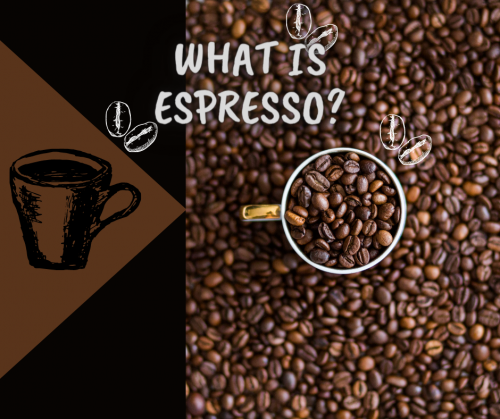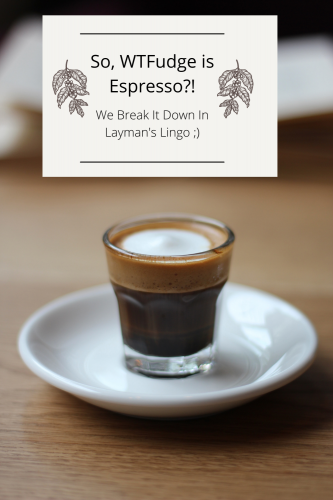If you’ve ever had espresso, you might be wondering what it is that really sets it apart from other types of coffee. And if you’ve never had espresso before, you’re missing out. But don’t worry; we’re going to explain it to you. Espresso is one of the most popular caffeinated beverages out there – and for good reason.
Here, we’ll take a look at what espresso is, the best ways to drink it, and more. We’re pretty sure that once you’re done reading, you’ll want to go grab – or better yet, make – some espresso.

What Is Espresso?
In simple terms, espresso is coffee. What makes it espresso – and completely sets it apart from coffee – is the brewing method, which originated in Italy. Brewed with an espresso machine, pressurized hot water is forced through finely ground coffee beans.
The end result? Espresso, a highly concentrated form of coffee.
One of the things that sets espresso apart from coffee is its crema, a light brown foam that’s created during the brewing process. Crema, which sits on top of the espresso, forms when the soluble oils from the coffee beans are combined with air bubbles. For information on espresso machines for home use, click here.
Choosing Espresso Beans
Espresso beans are simply coffee beans. You can use the same coffee beans you would use to brew coffee with, just as you can use espresso beans to make coffee.
Dark roasts are generally recommended when choosing espresso beans. This is because dark coffee tends to be more reliably consistent, as lighter roasts change as they age. Another reason why dark roasts are ideal for espresso is because they pair better with milk, so they’re more ideal for bringing the rich flavors out in cappuccinos and lattes.
Some people prefer medium or light blends when it comes to their espressos, however. There’s no real right or wrong answer. It’s a matter of personal preference.
Freshness does play a key role in making a good espresso. It’s best to use coffee beans one to three weeks after they’ve been roasted to produce the ultimate crema.
Choosing finely ground coffee beans is also essential to the process. Whether you choose to grind your own coffee beans or buy them pre-ground, it’s important to make sure that they are finely ground to create the best espresso possible.
Flavor Profile of Espresso
Just like coffee, espresso’s flavor will vary according to the exact roast that’s used. Since coffee beans can be used to make espresso, it’s possible to get just about any flavor from espresso. You can get the same sweet or fruity flavors if that’s what you opt for.
Although it depends on your own personal preferences, espresso is generally known for its rich, bold flavor. Most people prefer for it to be very bitter, but a good espresso will generally balance bitterness with sweetness and often consists of notes of caramel or nuts.
The crema is one of the main things that sets espresso’s flavor apart from coffee. It adds a thick, creaminess that coffee lacks. The crema helps add a sweet contrast to espresso’s rich, bold flavor, leaving behind a unique aftertaste.
Brewing Espresso
There are several ways to make espresso from the comfort of your own home. In order to make traditional Italian espresso, you will need to use an espresso machine. There are both manual and automatic espresso machines out there to choose from.
It is more efficient and easier to use an espresso machine, but it’s possible to make espresso-like coffee with a good coffee grinder. A kitchen scale is also recommended in order to weigh out the perfect espresso shot. If you want to make a latte or another coffee beverage with espresso, you’ll also need a milk frother.
There are plenty of DIY espresso guides on the internet to choose from. That being said, an espresso machine makes the process much easier.
Ways to Drink Espresso
Espresso can be enjoyed by itself. While it is served as a shot or as a double shot, it isn’t meant to be drunk all at once. In order to enjoy the rich, bold flavor that it offers, it’s best to drink it in slow, gradual sips. Although you can add sugar or another sweetener, most coffee connoisseurs prefer to drink it without any additives.
A lot of the time, espresso is served with biscotti or a scone to add some sweetness to your palate.
There are also a number of different drinks containing espresso that are served at cafes or coffee houses or can be made at home. Some of these include:
- Latte: A drink, which can be served either hot or iced, that contains four parts milk to one part espresso.
- Cappuccino: A popular beverage that is made from a shot of espresso topped with steamed and frothed milk.
- Caffé Americano: Often referred to as simply an Americano, this drink is made from a shot of espresso and hot water.
- Caffé macchiato: A drink containing espresso and a small amount of frothed milk.
- Red Eye: This drink is a cup of coffee topped off with a shot of espresso.
- Affogato: This caffeinated dessert is ice cream or gelato topped with a shot of espresso. Chocolate or caramel ice creams or gelatos are often used.
Although these are a few of the most well-known drinks containing espresso, it’s possible to add a shot or two of espresso to most coffee drinks.
How Much Caffeine Is in Espresso?

Most people think espresso contains more caffeine than caffeine. But is this true? The answer is complicated and not so black and white. Let’s break it down so that you can understand just how much caffeine you’re really drinking.
The amount of caffeine in espresso depends on the variety. A single shot of espresso may contain anywhere from 29 to 100 mg of caffeine, with most containing around 75 mg.
A double shot of espresso generally contains 58 to 185 mg of caffeine. In comparison, a cup of coffee generally contains 80 to 200 mg of caffeine.
While espresso can be higher in caffeine than coffee, it’s generally only enjoyed in smaller servings. A single shot of espresso is typically about one ounce, whereas a cup of coffee is usually enjoyed in an eight-ounce serving. So, while espresso does have a higher concentration of caffeine, many people actually consume less caffeine when they drink espresso than when they drink coffee – depending on how many shots or cups they’re drinking.
However, with certain beverages containing espresso, such as Red Eye, it is easy to surpass the amount of caffeine in a typical cup of coffee.
What is Espresso Conclusion
Now that you know so much about espresso, why not go out and try some? Whether you choose to make your own espresso or buy it from a coffee shop, you’ll be in for a real treat!